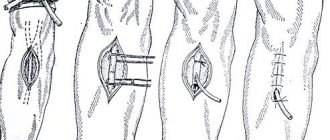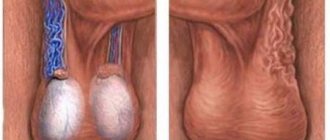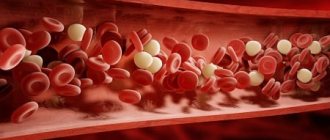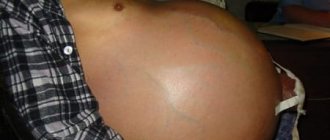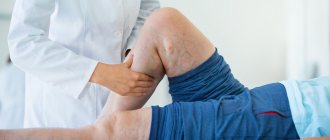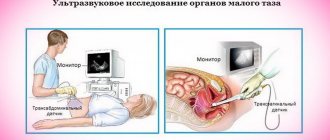Reasons for the development of the disease
We have already learned why the veins on the testicles in men enlarge. There are quite a few reasons that contribute to the development of this process. Among them:
- excessive and constant loads when exercising in the gym;
- performing work involving physical labor;
- the presence of congenital pathologies of the structure of blood vessels in the testicles;
- the presence of tumors in the pelvic or abdominal area;
- frequent constipation;
- prolonged absence of sexual activity.
Microsurgery
World surgical practice proves that the microsurgical method of treating blood vessels is the future. This type of varicocele surgery is increasingly used in domestic clinics. The intervention is carried out under local anesthesia using special microsurgical glasses and/or a microscope.
https://youtube.com/watch?v=TgSpG8xbY70
At the first stage, an incision is made at the root of the scrotum (up to 2 cm), and the pampiniform plexus with all the veins of the spermatic cord, including small ones that are not visible without a microscope, is brought out into the hole. The vessels are gradually ligated and divided, and external sutures are applied.
Microsurgical operation of varicocele, according to Marmar, has almost no disadvantages, and its advantages over other methods are:
- due to ligation of the smallest vessels, the possibility of relapse is eliminated;
- microscopic enlargement of the surgical field allows you to bypass the testicular artery, which is often damaged by other methods of surgical treatment;
- complete exclusion of the occurrence of dropsy, since the lymphatic drainage system of the testicles is not affected;
- The recovery period is characterized by a minimum or complete absence of pain, the patient returns to work the very next day, can play sports after the sutures are removed on the 7th day, recovery does not require a long period of time.
Summarizing all of the above, we can conclude that the most effective and least invasive intervention with minimal adverse consequences for the patient is the Marmara method.
Second stage
At this stage, the veins on the testicles of men continue to enlarge. While this cannot be determined visually, the man is not bothered by pain. Only one symptom may be present - discomfort in the testicular area.
During the second stage, the disease can be detected by palpation. In this case, the patient should be in an upright position and strain. In most cases, varicose veins in the testicles in men are detected in this way. This happens during the next preventive examination.
Symptoms of inguinal varicose veins
Signs of this disease are not pronounced. As a rule, varicose veins on the penis have symptoms that do not interfere with normal life. The clinical picture is such that it practically does not appear externally. It is this factor that contributes to the fact that most men do not share their problems with anyone. This can lead to the fact that varicose veins of the spermatic cord will progress until the situation becomes critical and irreparable.
Men of any age need to pay attention to the following symptoms:
- The appearance of pain in one or two testicles. The pain may be aching or pulling. Increased pain is observed with prolonged walking, standing or heavy work.
- A slight increase in the size of the left side of the scrotum. It droops slightly, which can only be seen upon careful inspection.
- Strengthening deformation processes. The scrotum swells and droops so much that it interferes with normal movement and sexual intercourse. The pain syndrome increases significantly.
- The occurrence of constant pain that does not depend on human activity. The scrotum is so enlarged that in order to walk normally, a person needs to wear tight underwear. Swollen blue venous nodes are visible on the penis and scrotum.
Symptoms may vary slightly in intensity. It depends on the age, physique and lifestyle of the man. If you do not start timely treatment, the consequences can be quite sad.
If a man does not respond in a timely manner to the pathology of the vascular system in the genital organs, he risks encountering the following problems:
- decreased potency;
- loss of sperm motility;
- dead sperm in semen;
- cessation of seminal fluid production.
Such phenomena are caused by the fact that blood circulation around the testicles increases, which leads to their overheating and impaired functionality. If you identify alarming symptoms, you should not self-medicate or go to healers and fortune tellers. Treatment of varicose veins is carried out only in a clinical setting.
Third stage
The disease develops, and the number of unpleasant symptoms continues to increase. The third stage is characterized by:
- the appearance of minor discomfort during physical activity;
- the occurrence of acute pain during sudden movements, increased stress or lifting heavy objects;
- nagging pain when the man is at rest.
The patient may notice a change in the shape of the testicle (in most cases, the left one), and the appearance of pronounced clusters of veins on it. The enlarged scrotum begins to interfere with walking.
In many cases, the third stage of this type of varicose veins is accompanied by a decrease in libido.
Symptoms of varicocele
The severity of clinical manifestations of the disease depends on the age of the patient:
- At an early stage of pathology, there are often no clinical symptoms.
- In many cases, this anomaly is discovered by medical commissions at military registration and enlistment offices.
- A tumor-like formation is palpable in the scrotal cavity.
- With significant physical effort, the patient experiences nagging pain in the groin area.
- In advanced cases, pain also occurs at rest.
There are three stages of varicocele:
- Mild degree. Upon palpation or straining, expanded clusters of the affected spermatic cord are determined.
- Average degree. The affected area is determined without straining during palpation.
- Pronounced degree. Without palpation, the cluster-shaped dilated veins of the testis are visually visible.
- In patients 15-18 years old, the 3rd degree of varicocele predominates, and among patients 12-14 years old - the 2nd degree of this disease.
Diagnosis of the disease
If the veins on the testicles enlarge in men and pain occurs in the groin area, you should immediately seek help from a doctor. Using one or more diagnostic methods, a specialist will be able to identify the presence of a problem and choose a way to get rid of it. Don't self-medicate!
To diagnose varicose veins on the testicles, the following can be used:
- Ultrasonography. It involves the use of Doppler ultrasound to assess blood flow. Ultrasound is performed twice. The first time the man will have to be in a horizontal position, the second - in a vertical position. If there is a need to obtain additional information, the patient may be prescribed venography.
- Functional tests.
- Feeling.
- Visual inspection.
If a man’s plans include conceiving a child, he will additionally be prescribed a test to determine sperm parameters.
Differential diagnosis of first degree varicocele
To make a diagnosis and draw up a treatment regimen, a patient with suspected varicocele should consult a urologist. The doctor will interview the patient and conduct an examination.
If nodules are found on the veins of the spermatic cord, you will definitely need to be examined:
- ultrasonography;
- donating blood to determine hormone concentrations;
- radioisotope studies;
- carrying out urography and phlebography;
- donation of sperm for analysis.
Depending on the situation, other diagnostic methods may be prescribed. The main task of the doctor will be to identify the cause of venous stagnation.
Drug therapy
This type of treatment is performed in cases where there is no need for surgical intervention. To prevent complications and speed up the body’s recovery processes, the patient may be prescribed:
- "Triovit";
- "Vitamax";
- grape seed oil.
Pentoxifylline-based medications are also taken. This group of medications can affect microcirculation in tissues. These include:
- "Trental";
- "Agapurin";
- "Orbiflex".
In this case, it is very important to follow the regimen prescribed by a specialist and not change the course of treatment at your discretion.
In order to prevent further development of the disease, the doctor may prescribe the use of venoprotectors. The most popular means from this group are:
- ginkgo biloba;
- "Escuzan";
- "Detralex."
Prevention
Every man suffering from varicocele wants to recover as quickly as possible and stop taking medications. To do this, you must follow some rules. Firstly, you need to give up smoking and alcohol, but at the same time it is not recommended to exhaust yourself with training. Secondly, a man needs to eat right. There is no special diet for varicose veins of the scrotum; it is enough to follow the generally accepted rules of a healthy diet: avoid excessively salty, spicy and fried foods, as they wear out blood vessels and often cause cholesterol plaques on the walls of blood vessels. You need to eat more fruits and vegetables, and take vitamin supplements if necessary.
Squats
In addition, it is recommended to perform exercises from the complex of therapeutic gymnastics: they provide a balanced load on the man’s body. Physical exercise is beneficial because it helps reduce the risk of complications and relapses. The daily set of exercises should include squats, “birch”, “scissors” and “bicycle”, it is allowed to work the abdominal muscles. The main thing is not to overexert yourself and do everything to the best of your ability.
Doctors recommend yoga as the best physical therapy for many diseases. It helps to tone the muscles and calm the nerves that can become “naughty” during the treatment of such a delicate disease as varicocele.
Varicocele is quite difficult to diagnose and is often recognized only in late stages. To prevent delays in treatment, you need to regularly visit your doctor and monitor your health yourself. The disease cannot be ignored, as it can lead to impotence and male infertility; fortunately, there are many treatments for varicose veins.
Surgery
As a rule, the third and fourth stages of the disease are treated with surgical intervention. Also indications for this type of therapy are:
- severe pain syndrome;
- deviations from the norm in spermogram results;
- failure of treatment with medications and other types of therapy;
- in adolescence – cessation of testicular growth.
There are several types of surgery that are performed to treat veins in the testicles in men:
- Open. The name of the operation known among urologists is according to Ivanissevich. As practice shows, despite its widespread use, this type of surgical intervention is ineffective compared to all others. Relapses of the disease after such an operation occur quite often.
- From mini-access (along Marmar). This is a modified form of the Ivanissevich operation. In this case, surgery is performed through a small incision, the length of which is about 2-3 centimeters.
- Laparoscopic (endoscopic). When carrying out such an operation, all actions are carried out under observation using a microcamera. All necessary instruments and equipment are introduced into the patient through tubes into the abdominal cavity. The occurrence of relapses of the disease in this case is possible only in cases where one of the branches remains unligated. Therefore, special attention is paid to the technique of surgical intervention. As for postoperative complications, they can manifest themselves in the form of hydrocele.
- Microsurgical revascularization. This method of surgical intervention is considered the most effective. The cost of its implementation is in the range of 40-60 thousand rubles. The essence of microsurgical revascularization is that the surgeon transplants the testicular vein into another, larger one. It’s probably not worth saying that this is jewelry work that requires high professionalism of a doctor.
After any type of surgical intervention, a man will have a recovery period.
How to fix the problem?
Treatment with drugs
It is possible to cure egg varicose veins without surgery, using medications of different effects. During conservative therapy, a man is recommended to wear compression garments, which the doctor will help you choose. It is aimed at stabilizing blood circulation in the testicles, reducing stress and pressure in the vessels. Medicines for varicose veins help cope with oxygen deficiency in tissues and restore spermatogenesis functions. The table shows popular pharmaceuticals.
| Drug group | Name |
| Antioxidants | "Triovit" |
| "Vitamax" | |
| Medicines that normalize blood circulation in the testicles | "Agapurin" |
| "Trental" | |
| "Orbiflex" | |
| Venoprotective drugs | "Eskuzan" |
| "Detralex" | |
| "Ginko biloba" |
Surgery is a last resort treatment
When varicose veins of the left testicle do not respond to conservative therapeutic measures, surgical intervention is prescribed. Surgery is also necessary if many venous nodes have formed. There are other indications for surgery:
- constant pain
- development of infertility,
- a damaged egg in a teenager stopped growing,
- negative impact of pathology on the psycho-emotional state of a man.
Previously, open surgery was performed according to Ivanissevich, in which the surgeon made an incision and tied the damaged venous plexus with a nylon thread to normalize blood circulation. This type of operation is performed extremely rarely; less traumatic treatments are often prescribed, which include:
- Laparoscopy. A small hole is made in the testicular area, through which instruments and a camera are inserted, while the process of excision of the damaged vein is monitored on a monitor. This endoscopic method is less likely to cause complications.
- Endovascular microsurgery. A sclerosing solution is injected into the diseased vessel, which glues the walls together, and the blood is redirected through healthy veins.
After surgical removal of testicular varicose veins, the man is prescribed medications that must be taken for 3 months to completely restore blood flow.
Folk remedies
Varicose veins, inflamed prostate and other diseases in the male genital area are amenable to alternative therapy. It is recommended to use natural components in the early stages of the disease, be sure to coordinate their use with a doctor. It is recommended to be treated not only with folk remedies, but also with pharmaceutical drugs to enhance effectiveness. At home, you can prepare healing ointments, decoctions for internal use and tinctures. Useful recipes for varicose veins:
- Apple tincture. The medicine is prepared from 3 medium-sized apples, which are poured with a liter of boiling water. Infuse the product for 3 hours, wrapped in a warm blanket. Crushed applesauce is consumed orally along with liquid, 50 grams in the morning and evening.
- Flower infusion. To prepare a medicinal product against varicose veins, you will need chamomile, rue, chestnut, raspberry root, yarrow and palm bark. All ingredients are taken in equal quantities, mixed and poured with boiling water. Leave for 24 hours and drink 150 ml twice a day.
Consequences of the disease
It is best to begin treatment of the disease at the earliest stages of its development. If even the slightest discomfort occurs, not to mention severe pain, you need to seek help from a specialist. Let us clarify that a urologist deals with the treatment of such diseases. Otherwise, a number of different complications may occur.
The disease is not fatal, but if it is present, the risk of tissue rupture due to testicular injuries increases significantly.
Another serious consequence of the pathology is the disruption of the process of sperm formation, their development and growth due to the lack of normal blood circulation. All this leads to the development of infertility. Statistics show that about 40% of men experience this complication of testicular varicose veins!
Other complications of varicocele include:
- development of the inflammatory process in the testicles;
- loss of sexual function;
- thrombophlebitis;
- development of cancer.
Male infertility and varicocele
Varicose veins of the testicles affect sexual function from several sides at once, so infertility can occur very quickly.
Varicocele reduces fertility due to the following factors:
- Increased testicular temperature
. Testicular temperature in healthy men is lower than body temperature. With varicose veins, the flow and flow of blood through the veins is disrupted. As a result, thermoregulation changes - the testicles heat up, which leads to a deterioration in the properties of sperm. Sperm motility and quantity decrease. - Compression of the testicles
. Enlarged veins compress the testicles, reducing spermatogenesis. Tissues atrophy. - Antibody production
. With varicocele, the immune system may begin to work erroneously, perceiving testicular tissue as foreign. The result of this is autoimmune inflammation of the scrotal organs and infertility. - Testicular hypoxia
. This is a syndrome of oxygen starvation, leading to tissue death. - Oxidation
. Due to impaired blood flow, free radicals accumulate in the tissues of the scrotum, causing tissue aging and cell death. - Throwing of biologically active substances
produced for the kidneys back from the adrenal glands into the testicles.
Urologists have proven the effect of testicular varicose veins on infertility in men, so the disease should be treated without waiting for problems.
However, there is no need to panic - the connection between testicular varicose veins and infertility
not always found:
- varicocele accompanies male infertility in 40%;
- in men with varicose veins, a deterioration in the quality and quantity of sperm is observed in 60% of cases.
Only a urologist can establish a connection between testicular varicose veins and decreased fertility. In any case, the pathology must be treated.
Preventive measures
Everyone knows that it is much easier to avoid a problem than to deal with its consequences later. Especially when it comes to your own health. Protecting yourself from varicose veins of the testicles is not so difficult. You just need to follow a few simple rules:
- Avoid strenuous physical activity.
- Do not lift heavy objects.
- Take care of normal bowel function. It is important to remember that constipation causes an increase in intra-abdominal pressure, as well as blood pressure in the pelvic organs.
- Stick to proper nutrition. This rule implies the exclusion of too fatty, heavy, and salty foods from the diet. Instead, it is better to add more fruits, vegetables, and herbs to your menu.
- Drink enough purified water. Green tea also helps prevent vascular conditions.
- Minimize the consumption of alcoholic beverages, stop smoking.
- Have regular sex life and avoid prolonged abstinence.
It is also important to undergo preventive examinations with a urologist in order to promptly notice the emergence of a problem and get rid of it in the initial stages.
Treatment methods for varicose veins
For quite a long time, doctors believed that testicular varicose veins in men in all cases leads to complete infertility. In this regard, when the disease was detected in adolescence, patients were offered surgery. But several decades ago, it was proven that infertility is an optional complication from varicose veins. Today, it is allowed to take medications for the treatment of varicocele.
Surgery for varicocele is prescribed in the following cases:
- Severe pain syndrome.
- Underdevelopment of the affected testicle was diagnosed.
- The testicle decreases in diameter.
Before the operation is performed, the dynamics of the development of testicular varicose veins are observed for one and a half to two years. Modern medical technologies make it possible to compare the sizes of both testicles with 100% accuracy and monitor the vein through which blood flow may be impaired.
In many cases, testicular varicose veins are diagnosed in men during a medical examination to determine suitability for military service. If a first stage varicocele is diagnosed, young men are referred for examination to a urologist, since there is a high probability of self-cure. To prevent varicose veins, it is recommended to wear special compression underwear, which helps normalize blood flow in the scrotum.
Taking medications is aimed at eliminating the following symptoms of the disease:
- To restore sufficient oxygen access to the tissues and blood vessels of the scrotum.
- Restoration of the process of spermatogenesis.
- Restoration of sperm motility.
The main drugs for testicular varicose veins that are prescribed to patients are antioxidants containing grape seed, for example, Vitomax and Triovit. To restore blood circulation, medications are prescribed that contain lentoxifylline - Trental, Agapurin. The course of administration and dosage of drugs is selected strictly individually.
The drug Detralex
Features of surgical treatment
An operation to eliminate congestion in the blood vessel of the testicle is prescribed as a preventive measure for the development of infertility in young men. In men over the age of 30, surgery is prescribed only in case of severe pain.
Today, the following surgical techniques are used:
- Open surgery according to Ivanissevich. It is performed under local anesthesia, with skin incision. The vein is ligated with a nylon thread to prevent reverse blood flow.
- The laparoscopy method involves inserting a special medical probe through a small cut in the skin. Used when there is a high risk of complications.
- Microsurgical endovascular operation - sclerosing substances are used to block the vessel.
Which method of surgical intervention to choose is decided by the attending physician, based on the characteristics of the course of the disease and the general condition of the patient. There are cases when the damaged vein is not ligated, but removed, and a new blood vessel is installed in its place. The postoperative period lasts about 3 months and includes the mandatory intake of medications - antioxidants and venoprotectors, if normalization of the blood circulation process has not been achieved.
Infertility with varicocele can only be avoided if the disease is diagnosed in a timely manner and treatment is properly selected. For any new, atypical sensations in the genital area, men should immediately seek medical advice before the disease begins to progress and causes severe consequences.
Video: Dilated veins on the testicles
Varicose veins of the testicles occur relatively often in men, affecting every sixth representative of the stronger sex. In medicine, such a disorder in the area of the male penis is known as a varicocele. With pathology, the veins in the area of the spermatic cords dilate. Swollen vessels in the scrotum provoke pain, impaired ejaculation and other problems. Ovarian varicose veins are more common in men under 25 years of age.
IT IS IMPORTANT TO KNOW! Even “advanced” varicose veins can be cured at home, without surgery or hospitals. Just read what Ekaterina Andreeva says and read the recommendation.
If enlarged testicular veins are not treated in time, the disease can lead to infertility and other complications.
Varicose veins of the testicles in men: symptoms at different stages, treatment
Varicose veins of the testicles in men are manifested by dilatation of the veins of the spermatic cord and lead to infertility. In most patients with this diagnosis, spermatogenesis is also impaired. According to statistics, 15-17% of the male population suffers from varicocele, and quite often the disease occurs without characteristic symptoms, so it is discovered only during a medical examination or at a draft board.
Causes of varicocele
Dilatation of the veins in the testicles occurs due to insufficiency of the valves of these vessels in the spermatic cord. Normally, the valves prevent the reverse flow of blood, but due to their loose closure, venous stagnation occurs.
There are several provoking factors for varicocele. These are all processes that lead to an increase in intra-abdominal pressure and prevent the outflow of venous blood:
- frequent physical overexertion;
- hereditary predisposition;
- prolonged stay of the body in an upright position;
- constipation caused by chronic intestinal diseases;
- obesity;
- constantly wearing uncomfortable tight underwear;
- tumor formations in the pelvic area or retroperitoneal space.
Intrauterine disorders lead to weakness of the vascular wall, underdevelopment of the valve apparatus or improper formation of the inferior vena cava. They cause the primary (idiopathic) form of varicocele.
Characteristic signs of varicocele
In most male patients, the varicocele affects the left testicle. This is due to the anatomical features of the venous system. Enlargement of the veins of the right testicle is observed in 4-8%, and damage to both sex glands is recorded in 2-12% of cases.
There are no symptoms of varicocele at the initial stage of the pathology.
The severity of the manifestations depends on the stage of the disease. At grade 0, changes in the venous network in the testicles are not determined by palpation examination (palpation). Dilation is found only on Doppler ultrasound or ultrasound of the scrotum. At the first stage, varicocele veins can be felt in an upright position, and in a lying position they return to their normal state.
When the second stage occurs, dilated veins are detected by touch in any position of the patient’s body. The third degree is characterized by the fact that stagnation and pathological changes are detected immediately upon visual examination.
In the last two stages, men develop characteristic symptoms:
- pressing or pulling pain in the scrotum of varying intensity;
- discomfort when walking;
- burning sensation;
- sexual dysfunction;
- increased pain after straining or physical exertion.
When examining the patient, a pronounced venous network is visible on the testicles. On the affected side, the scrotum enlarges and sags, causing asymmetry. When varicose veins of the left testicle develop, prolapse of the left side of the scrotum becomes noticeable. As the disease progresses, the pain in men becomes more intense, and the symptoms become permanent.
Left-sided varicocele develops due to the fact that the pampiniform venous plexus from the left testicle and spermatic cord enters the renal vein at an angle of 90%.
This slows down the flow of blood and provokes its regurgitation (reverse flow). Cases have been described in which the renal vein was pinched between the aorta and the mesenteric artery.
Such compression further complicates the outflow of blood and provokes the development of varicocele on the left.
Principles of treatment
Treatment of varicocele should begin immediately after its discovery, otherwise the consequences will become irreversible. If the cause of the disease is identified, they act on it first.
Preventive measures
Varicose veins of the testicle in men in the initial stages are not subject to surgical treatment. To improve the condition with 0 and 1 degrees of varicose veins, doctors recommend:
- avoid constipation;
- promptly treat intestinal inflammation;
- Limit heavy lifting and physical overload.
For an elderly person, wearing a suspensor brings significant relief. This is a special pant-shaped bandage that supports the testicles.
To improve venous blood flow, venotonics are used - drugs that tonify the vein wall. Sometimes a man needs a course of hormone replacement therapy. In parallel with the main treatment, vitamins in combination with microelements are prescribed. The body especially needs the supply of selenium and zinc, ascorbic acid - it strengthens the walls of blood vessels.
Surgery
When the disease progresses and reaches extreme stages, no conservative methods, much less traditional medicine recipes, will help. The only option to restore normal blood flow is surgical treatment. Indications for surgery are the following conditions:
- the vein is suddenly swollen and there is severe pain;
- decreased quality and quantity of sperm;
- disorders of puberty in adolescents;
- significant decrease in testicle size;
- a cosmetic defect causes inconvenience;
- varicocele of the third stage and higher.
Various surgical techniques eliminate the consequences of venous expansion. Surgically it is possible to prevent the development of infertility and testicular sclerosis. At the same time, pain is relieved, quality of life improves and the normal shape of the scrotum is restored. When indicated, the operation is performed on both adolescents and adult men.
Modern medicine uses classical and innovative methods of therapy for the expansion of the pampiniform plexus of the testicle and spermatic cord. Treatment is carried out using the following methods:
- open access with intersection of veins and collaterals;
- removal using laparoscopy;
- X-ray endovascular methods (coagulation, embolization, sclerotherapy);
- creation of vascular anastomoses to restore blood outflow.
Many surgeons use the traditional approach. It is still considered effective and is widely used in practice, but recently more modern methods have been introduced.
The laparoscopic technique allows you to minimize the recovery period after surgery. This minimally invasive operation is less traumatic and occurs with minimal complications.
The laparoscopic technique allows you to restore the ability to conceive and prevent atrophic changes in the testicles.
Cauterization of a vein or injection of a sclerosant (a special substance for gluing blood vessels) almost always occurs without complications. But the disadvantage of this treatment is the high relapse rate.
Source: https://azbukaurologa.ru/yaichki/varikoz-yaichek-u-muzhchin

